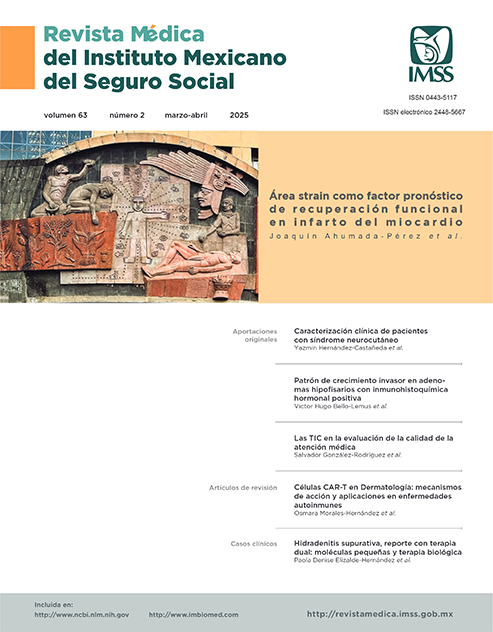Cryptococcus albidus, Naganishia albida, primary skin infection, first case reported in Mexico
Main Article Content
Keywords
Bacterial Infections and Mycoses, Skin Diseases, Immune System , Fluconazole
Abstract
Background: The increase in immunosuppressive treatments and diseases that affect cellular immunity, such as diabetes, renal disease, and oncological or rheumatological conditions, has led to a rise in infections caused by opportunistic microorganisms. The aim of this work is to identify Naganishia albida as an infectious pathogen in immunocompromised patients, highlighting its importance and clinical evolution.
Clinical case: One of the first identified cases of Naganishia albida is reported in a patient with immunosuppression secondary to oncological treatment, with domestic activity exposure being the main risk factor. The patient had a good clinical outcome due to timely diagnosis, guided by biopsy culture and reverse stains.
Conclusion: Given the increase in conditions that affect the immune system, it is crucial for physicians of any specialty to pay special attention to secondary infections caused by immunosuppression. Without appropriate treatment, these infections can become invasive, negatively impacting the prognosis and evolution of the patient.
References
Martín-Mazuelos E, Valverde-Conde A. Criptococosis: diagnóstico microbiológico y estudio de la sensibilidad in vitro. Sociedad Española de Enfermedades Infecciosas y Microbiología Clínica. Disponible en: http://www.seimc.org/contenidos/ccs/revisionestematicas/micologia/cripto.pdf
López SR, Álvarez VA, Juanes JS. Cutaneous cryptococcosis. Medicina Clínica (English Edition). 2019;152(1):e5.
Gordon PM, Ormerod AD, Harvey G, et al. Cutaneous cryptococcal infection without immunodeficiency. Clinical and Experimental Dermatology. 1994;19(2):181-4. Disponible en: https://pubmed.ncbi.nlm.nih.gov/8050156/
Neuville S, Dromer F, Morin O, et al. Primary Cutaneous Cryptococcosis: A Distinct Clinical Entity. Clin Infect Dis. 2003; 36(3):337–47.
Oliveira VF de, Funari AP, Taborda M, et al. Cutaneous Naganishia albida (Cryptococcus albidus) infection: a case report and literature review. Revista Do Instituto De Medicina Tropical De Sao Paulo. 2023;65:e60. Disponible en: http://pubmed.ncbi.nlm.nih.gov/38055378/#:~:text=Naganishia%20albida%20(Cryptococcus%20albidu
Martín-Mazuelos E, Aller-García AI. Aspectos microbiológicos de la criptococosis en la era post-TARGA. Enfermedades Infecciosas y Microbiología Clínica. 2010;28(Supl 1): 40-45. Disponible en: https://seimc.org/contenidos/ccs/revisionestematicas/micologia/ccs-2008-micologia.pdf
Dannaoui E, Abdul M, Arpin M, et al. Results Obtained with Various Antifungal Susceptibility Testing Methods Do Not Predict Early Clinical Outcome in Patients with Cryptococcosis. Antimicrobial Agents and Chemotherapy. 2006;50(7): 2464-70.
Aller AI, Martín-Mazuelos E, Lozano F, et al. Correlation of Fluconazole MICs with Clinical Outcome in Cryptococcal Infection. Antimicrob Agents Chemother. 2000;44(6):1544-8.
Melhem MSC, Pereira-Leite D Jr, Takahashi JPF, et al. Antifungal Resistance in Cryptococcal Infections. Pathogens. 2024;13(2):128-8.
Burnik C, Altintaş N, Özkaya G, et al. Acute respiratory distress syndrome due to Cryptococcus albidus pneumonia: case report and review of the literature. Med Mycol. 2007;45 (5):469-73.
Perkins A, Gomez-Lopez A, Mellado E, et al. Rates of antifungal resistance among Spanish clinical isolates of Cryptococcus neoformans var. neoformans. Journal of Antimicrobial Chemotherapy. 2005;56(6):1144-7.
Powderly WG, Anucha Apisarnthanarak. Treatment of acute cryptococcal disease. Expert Opinion on Pharmacotherapy. 2001;2(8):1259–68.
Mccurdy LH, Morrow JD. Infections due to non-neoformans cryptococcal species. Comprehensive Therapy. 2003;29(2-3):95-101. Disponible en: https://pubmed.ncbi.nlm.nih.gov/ 14606338/
Endo JO, Klein SZ, Pirozzi M, et al. Generalized Cryptococcus albidus in an immunosuppressed patient with palmopustular psoriasis. Cutis. 2011;88(3):129-32. Disponible en: http://pubmed.ncbi.nlm.nih.gov/22017065/
Gyimesi A, Bátor A, Görög P, et al. CutaneousCryptococcus albidus infection. Int J Dermatol. 2017;56(4):452-454. doi: 10.1111/ijd.13576.
Gharehbolagh SA, Nasimi M, Agha-Kuchak A, et al. First case of superficial infection due to Naganishia albida (formerly Cryptococcus albidus) in Iran: A review of the literature. Current Medical Mycology. 2017;3(2):33-7.
Villanueva OGS, Ortiz AJI, Ruiz EJA, et al. Criptococosis cutánea: reporte de caso en un paciente con linfoma de Hodgkin. Dermatología Cosmética, Médica y Quirúrgica. 2022;20 (3):299-302.
Liu XZ, Wang QM, Göker M, et al. Towards an integrated phylogenetic classification of the Tremellomycetes. Studies in Mycology. 2015;81(1):85-147.
Lee YA, Kim HJ, Lee TW, et al. First Report of Cryptococcus Albidus-Induced Disseminated. Korean J Intern Med. 2004; 19(1):53-57.
Hoang JK, Burruss J. Localized cutaneous Cryptococcus albidus infection in a 14-year-old boy on etanercept therapy. Pediatric Dermatology. 2007;24(3):285-8. Disponible en: https://pubmed.ncbi.nlm.nih.gov/17542882/
Jackson KM, Kabbale KD, Macchietto M, et al. Virulence-associated variants in Cryptococcus neoformans sequence type 93 are less likely to be associated with population structure compared to independent rare mutations. Microbiology Spectrum. 2025;13(1):e0170924. Disponible en: https://doi. org/10.1128/spectrum.01709-24
Narayan S, Batta K, Colloby P, et al. CutaneousCryptococcusinfection due to C. albidusassociated with Sézary syndrome. British Journal of Dermatology. 2000;143(3):632-4.


